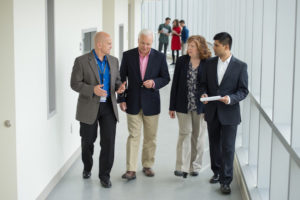Empire State Development’s Division of Science, Technology, and Innovation (NYSTAR) has re-designated Syracuse University College of Law’s Technology Commercialization Law Program (TCLP) as the New York State Science and Technology Law Center (NYSSTLC, or Law Center). Having served as the NYSTAR Law Center for four consecutive, three-year terms, TCLP’s faculty and students will continue to support the state’s economic development by helping entrepreneurs determine prospects for the success of new and emerging technology in the marketplace.
The re-designation the Law Center is a testament to the exceptional experience in technology commercialization strategy, intellectual property assessment, patent landscaping, technology licensing, R&D, technology transfer, and entrepreneurship education of the College of Law’s technology commercialization and intellectual property faculty, led by Law Center Director M. Jack Rudnick and Crandall Melvin Professor of Law Shubha Ghosh. Supplementing this expertise is TCLP’s cornerstone Technology Commercialization Research Center (LAW 815). Now in its 25th year, the Research Center allows students from the College and across campus to work with entrepreneurs, companies, universities and research centers throughout the state.
“I am extremely pleased that NYSTAR has granted the College of Law the coveted designation as the only New York State Science and Technology Commercialization Law Center (NYSSTLC),” says Craig M. Boise, Dean, Syracuse University College of Law. “NYSTAR’s action is an explicit recognition of our faculty’s strength in this area, as well as our students’ hard work and creativity. Coupled with the College of Law’s TCLP, NYSSTLC allows us to partner with industries across New York, to support economic development in the state, and to provide a law curriculum that is rich in hands-on, practical experience. Our innovative research and teaching in this area are-and will continue to be-attractive to prospective students interested in pursuing both traditional and non-traditional legal careers in the dynamic field of technology commercialization.”
“Our network of NYSTAR-supported centers is crucial to New York State’s innovation economy, providing assistance that helps companies transform concepts into realities,” says Empire State Development President, CEO, and Commissioner Howard Zemsky. “The Science and Technology Law Center continues to offer unparalleled research and legal solutions for a range of businesses and sectors, and I congratulate the College of Law’s faculty and students on their re-designation.”
“We are excited and pleased to have been re-designated as the NYSSTLC. I believe the re-designation recognizes the unique skills and growth of TCLP staff, students, and researchers who do the work,” says Rudnick. “Since 2004, we have earned an excellent reputation for helping startups, and I am not aware of any similar program or capability anywhere in New York State.”
Since its initial NYSSTLC designation in 2004, the Law Center has accumulated an extensive body of research, educational materials, consulting services, high-quality academic offerings, and information forums-including conferences, webcasts, newsletters, and guidebooks-that promote economic growth in the state by helping to transform research and technology into business.
Among services that the Law Center will continue to provide on behalf of NYSTAR, faculty and students will help to increase awareness and understanding of legal issues in commercialization, such as intellectual property protection; technology transfer; patents, copyrights, and trademarks; and licensing agreements. They also will advise state centers for advanced technology, centers of excellence, incubators, innovation hot spots, regional manufacturing extension partnership centers, and others on technology-related legal issues.
The SU Law Center has expanded its services over the last five years to keep pace with the growth of tech startups in the state. During the most recent designation, NYSSTLC completed approximately 150 research projects at an average rate of 50 projects a year. According to Rudnick, the Law Center takes in clients from all over New York State seeking the assistance of the Law Center, Syracuse University’s extended Innovation Ecosystem, and other organizations dedicated to tech startups.
“Whether tech startup assistance is provided in Syracuse or some other region of the state, NYSSTLC often is involved,” says Rudnick. “Our program also reaches out across the University’s Innovation Ecosystem to engage the campus’s tech startup community wherever possible. For instance, the Law Center has a long-standing relationship with Whitman’s Entrepreneurship and Emerging Enterprises program, and its students work as part of our teams. We have helped many entrepreneurs looking to develop their business and students looking to launch their careers, and we intend to continue.”
Rudnick says his plans for the future are optimistic and expansive. “We are developing a special curriculum for non-legal students, offering transition services for individuals who want to make the move themselves from the lab to the market,” he says. “Moreover, we plan to invigorate the network of tech commercialization clinics around the state, and we will expand our very popular guidebook series, adding more issues on topics relevant to innovation.”






